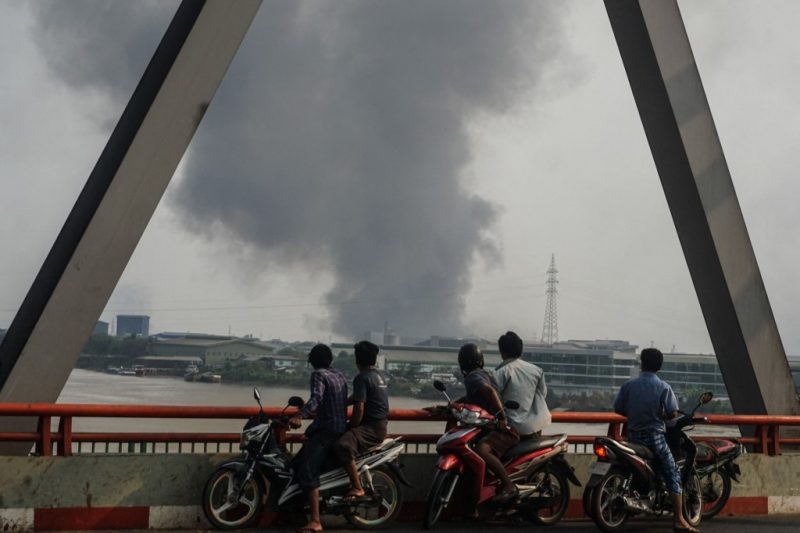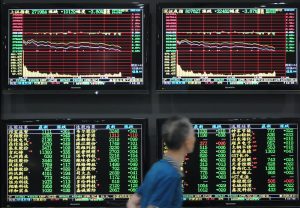(AF) Chinese businesses have been targeted in Myanmar as massive public opposition to the coup continues to make a severe impact on business and foreign investment.
On Monday March 15, the Chinese Embassy revealed that some 32 Chinese-backed factories in the Laydaya Industrial Zone had been “smashed by criminals” on the previous day, causing property loss of at least 240 million yuan (nearly US$37 million).
Two Chinese employees were injured during arson attacks in six areas, while protesters suffered horrendous casualties when soldiers and police opened fire on them. More than 50 were reportedly killed in Yangon on Sunday, as well as at least 16 others in Mandalay, Bago and other towns.
Early reports by Myanmar state media said three Chinese-owned factories were burnt down in Yangon townships – allegedly by protesters – amid fierce clashes in the commercial capital on Sunday, as ill-feeling raged against their neighbour to the north, which has been one of two powerful supporters of the Myanmar military in United Nations forums (along with Russia) discussing ways to cool down the crisis in the troubled Southeast Asian nation.
However, there have been claims on social media in the days since that these factories were deliberately torched by people hired by the Myanmar military.
One Burmese-language report had a photo of a Chinese man who allegedly witnessed the arson attacks “by military terrorists” and said the people responsible also shot him. This is feasible, given the nature and history of the Myanmar military and the massive opposition they are currently facing all over the country.
State-run media said late on Sunday that five factories in the garment-producing townships adjacent to Yangon had been razed. The Chinese Embassy in Myanmar later condemned actions of the “destroyers”, in a statement posted on their official Facebook account. It said late on Sunday that over a dozen factories in various industrial zones suffered arson or were “smashed”, but the embassy tally on the damage was raised to 32 factories the next day.
Most of the companies involved were Chinese-funded enterprises or Sino-Myanmar joint ventures – garment processing factories, garment accessories and ancillary equipment factories mainly. Chinese officials alleged that most of the arsonists rode motorcycles and carried iron rods, axes and petrol drums. A Chinese media report said the attackers “smashed and intimidated the factory staff on duty, then set fire to them”.
The embassy got in touch with the Myanmar Chinese Enterprise Chamber of Commerce and related companies as soon as possible, and quickly asked local police to take effective measures to ensure the safety of Chinese companies and personnel. The embassy also issued further safety reminders to Chinese enterprises and personnel in Myanmar.
China has had relatively good relations with the military in Myanmar since the early for several decades, and it has said it regards the coup staged by the military on February 1 as another country’s “internal affair”.
Late on Sunday, state-run media announced that the massive Hlaing Tharyar township and the neighbouring Shwepyitha township would be put under martial law.
The vast and impoverished townships are factory hubs and home to garment factories. They were scenes of shocking violence on Sunday.
The military junta “gives administrative and judicial martial law power to the Yangon regional commander… to perform security, maintain the rule of law and tranquility more effectively,” an announcer on state-run TV was quoted as saying.
Soldiers and police have been staging near-daily crackdowns in recent weeks against demonstrators calling for a return to democracy, using tear gas and firing rubber bullets and live rounds to quell anti-coup protests.
In Hlaing Tharyar township police and soldiers clashed violently, with protesters allegedly wielding sticks and knives and rushing for protection behind makeshift barricades.
Myanmar Now put the death toll in Yangon on Sunday at close to 60, making it the most deadly day by far.
The turmoil in Myanmar has also hit rare earth traders in China, AF has reported previously. Prices of neodymium praseodymium oxide have risen to 530,000 yuan a tonne, up about 10% from last week – and more than 80% over its price in June last year.
Protests Outside Chinese Embassy
It is not known if protesters caused the fires on Sunday. Mobs have been protesting outside the Chinese Embassy for weeks and taunting its diplomats that China’s pipelines across the northwest of Myanmar could also be targeted.
The rise in anti-China sentiment has raised questions in Myanmar business circles and in China, not only over the surge of Chinese investment in recent years but for billions of dollars earmarked for northern Rakhine State as part of the “Belt and Road” infrastructure plan.
The gas pipeline, which carries gas from Myanmar’s offshore fields, opened in 2013, as Myanmar’s military was starting democratic reforms. A $1.5 billion 770-km oil pipeline, which pumps crude shipped from the Middle East to Kyauk Phyu in Rakhine State and then up to Yunnan in southern China, started in 2017 under the government of elected leader Aung San Suu Kyi, who is now detained and facing an array of charges.
A PetroChina official told Reuters late last week there had been no problems yet with the operation of the oil pipeline, which is the only source of crude for the state energy giant’s refinery in Kunming.
Protests over the pipeline flared after a Myanmar government document leaked from a February 24 meeting showed Chinese officials had asked Myanmar’s junta to provide better security – and intelligence on ethnic minority armed groups on the pipeline route.
China’s foreign ministry has called for “all sides in Myanmar to exercise calm and restraint” and to resolve their differences, saying: “Safeguarding the security of bilateral cooperation projects is the common responsibility of both China and Myanmar.”
Billions of dollars had been earmarked for such projects, including an economic corridor ending at a $1.3 billion deepwater port and industrial zones off Kyauk Phyu, plus a new city next to Yangon and a railway to the border.
“Hostile public opinion will inflict long-term threats and damage to China’s plan,” Yun Sun, director of the China Program at the Washington-based Stimson Center, said. She noted damage done to Beijing’s reputation over the Myitsone Dam, a highly contentious $3.5-billion project in northern Kachin state that was shelved in 2011 amid a local outcry, but one that China has sought to reactivate.
China had also tried to keep close to Suu Kyi, while maintaining ties to the army that overthrew her. But balancing these relationships has become more and more precarious.
Thais Planning More Refugee Camps
Meanwhile, in an ominous sign, the Thai army on Monday (March 15) said it plans to set up temporary camps in Ranong and Chumphon provinces, several hours south of Bangkok, for Myanmar nationals fleeing political violence, as the death toll among protesters opposed to the military coup there continues to escalate.
Maj Gen Santi Sakuntak, commander of the Thep Satri Task Force, said on Monday that Muang, La-un and Kra Buri districts in Ranong and Tha Sae district in neighbouring Chumphon have been designated as areas for temporary shelters.
He said Thailand would accept them on humanitarian grounds and send them back after the situation returns to normal, instead of setting up permanent refugee camps at the border.
Thailand and Myanmar share a 2,400km border, and relations between the two countries’ military leaders are currently close and warm. So, the fact that Thai leaders – who were previous seen as anxious to return refugees who have lived in the country for several decades already – suggests they fear the crisis in Myanmar will get far worse in coming months.
Bangkok was criticized last week by rights groups for turning back refugees who attempted to cross into the Kingdom from Tachilek (opposite Mae Sai in the far north), but officials denied them entry, saying they risked bringing Covid-19 and causing a health crisis.
Thailand has had nine refugee camps for Karen, Burmese and ethnic minorities from Myanmar since the 1980s and 90s. These camps – from Kanchanaburi, two hours east of Bangkok, right up to Mae Hong Son in the far northwest – held at least 150,000 refugees until a decade ago, but their number declined to about 98,000 after tens of thousands were resettled in the US and other Western nations.
A few thousand also returned back to their homeland, however, the bulk of these people have remained, insisting that even when Suu Kyi was State Counsellor the Burmese Army was still terrorizing citizens in border areas.
- Jim Pollard and Chris Gill, with reporting by AFP and Reuters.
NOTE: This report was amended on Tuesday March 16, 2021 after claims emerged that cast doubt on whether protesters were responsible for the factory fires in Yangon. Further minor edits were done on July 20, 2022 when the page was upgraded to new style standards.
ALSO SEE:
Myanmar Crisis Poses Risks to Global Rare Earth Supply Chain
Myanmar Coup: Did the Generals Fear Losing Their Billions?
























